简体中文
繁體中文
English
Pусский
日本語
ภาษาไทย
Tiếng Việt
Bahasa Indonesia
Español
हिन्दी
Filippiiniläinen
Français
Deutsch
Português
Türkçe
한국어
العربية
Visa Adds PYUSD, EURC, and USDG to Stablecoin Payments
Abstract:Visa expands blockchain payments with PayPal PYUSD, EURC, and USDG stablecoins, advancing digital settlements in the growing crypto payment space.

Visa is accelerating its crypto push, announcing fresh Visa stablecoin support that broadens both the currencies and the blockchains available on its global payments rails. The latest upgrade brings three new tokens—PayPal‘s PYUSD, the euro-backed EURC, and Global Dollar (USDG)—plus connectivity to the Avalanche and Stellar networks. The move signals Visa’s intent to meet rising institutional and consumer demand for faster, cheaper digital settlements without abandoning the familiarity of a card swipe.
Under the update, holders of PayPal‘s PYUSD stablecoin Visa integration can now settle purchases or move funds across borders with the same ease as sending an email. The euro-denominated EURC Circle Visa pairing targets exporters and tourists who want to avoid costly FX spreads, while the USDG Paxos Visa link gives businesses in emerging markets a new on-ramp to dollar liquidity. All three assets ride alongside the long-supported USDC, extending Visa’s multi-currency portfolio at a time when regulators are writing clearer rules for dollar-pegged tokens.
Regulators, Rivals, and Retailers Join the Stablecoin Rush
Lawmakers‘ recent passage of the GENIUS Stablecoin Act has pushed banks, fintechs, and retailers to accelerate their own experiments. JPMorgan is trial-running tokenized deposits for wholesale clients, while Mastercard says nearly one-third of its volume is already tokenized. Amazon and Walmart are studying in-house coins for loyalty and cross-border checkout. With the competitive heat rising, Visa’s decision to plug into the Avalanche Stellar Visa blockchain combo gives merchants instant access to two high-speed networks known for low fees and quick finality—advantages expected to lift stablecoin payment volumes well beyond the companys disclosed US$225 million to date.
The technical playbook is straightforward but powerful: merchants can accept a supported stablecoin, instantly convert it to fiat, and receive settlement in their bank account—often within minutes. Consumers see no change at the checkout counter; they still tap, dip, or click a familiar Visa button. Behind the scenes, however, value races along multiple blockchains rather than through decades-old card rails. By abstracting away the wallet addresses and gas fees, Visa offers an on-ramp for traditional finance that has so far eluded many crypto-native payment startups.

Industry analysts say the big winner could be cross-border commerce, a US$150 billion market saddled with slow correspondent banking chains and opaque fees. A European freelancer paid in EURC could cash out euros instantly, while a Latin American supplier might invoice in USDG and sidestep local currency volatility. For PayPal, the partnership is validation that its stablecoin can reach millions of Visa-enabled merchants without building its own acceptance network from scratch.
The expansion caps a busy year for Visa‘s crypto unit. It invested in stablecoin processor BVNK in May, rolled out on-chain settlement pilots with Crypto.com and Coinbase, and helped Binance launch a euro-denominated debit card before the exchange exited several markets. Each initiative feeds data back into Visa’s risk engines, allowing the company to refine anti-fraud tools that monitor both on-chain and off-chain behavior.
Still, challenges loom. Compliance teams must track wallet provenance across multiple chains, and treasury desks need strategies for off-ramping large sums without moving markets. Visa executives say the answer lies in partnerships with regulated issuers such as Circle and Paxos, whose reserves are audited and whose tokens obey sanctions lists.
Whether stablecoins ultimately replace or simply augment legacy payment rails, Visa has made its position clear: it will process value wherever customers choose to spend it. By knitting together PYUSD, EURC, USDG, and two new blockchains, the company is betting that the next wave of commerce will be settled at internet speed—and that the familiar Visa badge will remain front and center when it does.
Download and install the WikiFX app by scanning the QR code below to access the latest news and updates.

Disclaimer:
The views in this article only represent the author's personal views, and do not constitute investment advice on this platform. This platform does not guarantee the accuracy, completeness and timeliness of the information in the article, and will not be liable for any loss caused by the use of or reliance on the information in the article.
Read more

HKMA Launches Stablecoin Licensing Rules Ahead of August 2025 Deadline
HKMA’s Stablecoins Ordinance and licensing guidelines take effect August 1, 2025, defining Hong Kong’s digital asset regulation landscape for stablecoin issuers.

SkyLine Judge Community: Appreciation Dinner Successfully Held in Malaysia
On August 1, 2025, the SkyLine Judge Appreciation Dinner was successfully held in Kuala Lumpur, Malaysia. As the first WikiFX SkyLine event in Malaysia this year, the dinner not only aimed to express sincere gratitude to expert judges, partners, and industry representatives who have long supported the development of the SkyLine Judge Community but also facilitated in-depth discussions on the future direction of forex trading safety, financial education, and industry transparency.

AssetsFX Scam Alert: 5 Troubling Signs
Forex trading has become a critical game now because of advancements in technology. Due to this Unfortunately, scam brokers have also entered in the Forex market. Therefore, you need to stay alert. This article aims to warn all traders and investors. Read carefully and stay aware.

What are Indian Traders saying about MINTCFD?
MINTCFD is an India-based broker. It's important to note that independent watchdogs have issued scam alerts against the broker. They label MintCFD as risky and possibly fraudulent. In this Article, we will tell you the red flags of MINTCFD to protect your money
WikiFX Broker
Latest News
SkyLine Judge Community: Appreciation Dinner Successfully Held in Malaysia
Think Uncle Sam Owes $37 Trillion? It's Far Worse Than That
HKMA Launches Stablecoin Licensing Rules Ahead of August 2025 Deadline
Visa Adds PYUSD, EURC, and USDG to Stablecoin Payments
Currency Calculator


